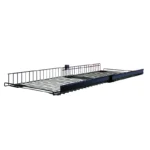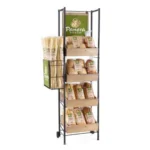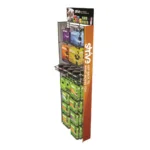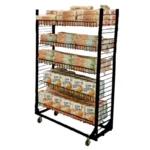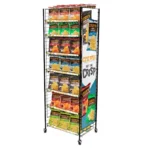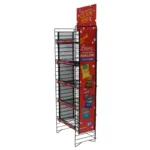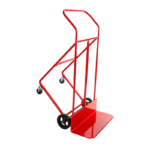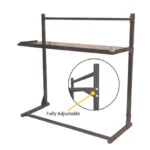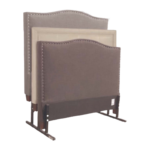In the fiercely competitive landscape of supermarket retail, food brands vie for attention. Each seeking to claim a prime spot on the store shelves and in the eyes of the buying consumer. However, getting lost amidst a sea of similar products among thousands of supermarket displays is a common challenge for brands across virtually every food category. That’s where the power of effective merchandising comes into play. In the latest blog from Bordertown Retail, we explore how proper food displays can increase revenue for supermarkets.
Fact: a well-designed retail display can be the key to positioning your brand for success, catching the eye of consumers and driving impulse purchases. Unlike any other medium, these solutions pose a significant impact on customer behavior and are a testament to the persuasive power of visual appeal. By creating engaging displays through actionable strategy and effective placement, supermarkets can unlock that power.
Food Displays: Maximizing Sales, Increasing Revenue
The advantages of proper displays in retail settings are well-known. But what really underpins these advantages? Whilst there are decades of research and facts to draw upon, we have summarized these in three key points based on our first-hand experience.
1. Drive a Rapid Sales Lift
The success of Unique Snacks is just one example of how display programs can revolutionize a brand’s sales performance. By implementing our end caps and placing their products strategically in prominent locations, this brand witnessed a 38% sales lift in less than a month.
2. Delight Supermarkets With Increased Sales Volume
The success of display programs are not limited to the brands they stock. Supermarkets, too, benefit significantly from partnering with food brands that embrace this strategy. By encouraging brands to invest in eye-catching food displays, supermarkets can effectively drive more volume out the door and increase their own sales per month. It’s a win-win.
3. Transform Brand Success From Bottom to Top
One of the most compelling aspects of display programs is their transformative effect on brand success. A well-executed display has the potential to catapult a brand from a bottom-selling product to a top performer within a relatively short period. The enhanced visibility and increased sales volume generated by displays can significantly alter a brand’s standing in the market – and that of the supermarket that stocks it.
The Impact of a Display on Customer Behavior

Whilst cross-merchandising and general marketing efforts are essential to selling a product, the importance of proper food displays in relation to customer behavior shouldn’t be underestimated. Let’s take a look at some of the core benefits of taking a more considered and strategic approach to displays.
1. Stand Out from the Food Brand Competition
The market is awash with competing brands, competing visuals and competing messages. It is no secret that consumers tend to feel overwhelmed with the scale of choice on offer. Many products are similar and customers tend to purchase a product that directly faces them and visually entices them.
However, in many retail outlets, snack brands will be randomly placed on an empty shelf and blend into their surroundings. This surrenders their visual appeal and much of the work that’s gone into their brand identity.
By strategically placing your products on eye-catching displays, you create an attractive focal point that draws the shoppers’ attention away from the routine shelf browsing. A well-executed display entices consumers to take notice, and that old mantra of “the first impression is the last impression” rarely rings so true.
Indeed, creating that lasting first impression is about more than just securing that one-time transaction. Capturing consumers’ attention in-store can be a pivotal moment that leads to increased brand recognition and loyalty; both for supermarkets and for the brands that they stock.
2. Position Your Brand for Impulse-Purchase Success
As previously mentioned, the benefits of creating long-term brand recognition and customer loyalty cannot be overstated. However, a critical aspect of understanding consumer psychology is in understanding the dynamics of in-store consumer behavior.
The statistics in this area speak for themselves. A recent survey conducted in 2022, by Statista, suggested that consumers in the United States spent an average of over 300 U.S. dollars on impulse purchases each month.
These figures should be viewed with the added understanding that approximately 82% of buying decisions are made in-store. With this in mind, the benefits of having that perfect retail display are obvious.
3. Take Advantage of Convenience & Personalization
When it comes to product placement in supermarket displays, there’s a little more to consider than simply standing out and encouraging consumers to impulse buy. It is equally important to consider the importance of both personalization and convenience.
- Personalization: Research has found that companies who excel at personalization generate 40% more revenue from those activities than average players. Behind this statistic is a simple, yet powerful concept. Shoppers want that personal experience they can share with their friends and family as well as on their social media, so they can feel good about themselves.
- Convenience: This is key. We don’t just purchase according to what we see, but what is easiest to lift off the shelf. Consider this: 72% of shoppers complete their grocery shopping in 44 minutes. This reflects that your customers prefer to avoid crowded aisles and long queues. By positioning your products strategically, you can appeal to these bored and often rushed shoppers.
How to Create an Engaging and Effective Display
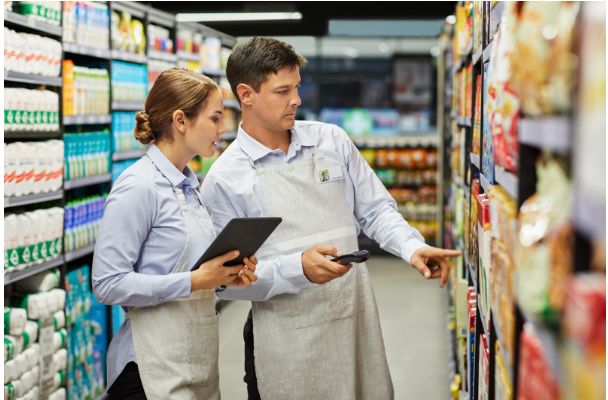
When supermarkets are adorned with attractive displays, the shopping experience becomes more engaging and enjoyable for consumers. In the next section, we highlight some key tips for creating an effective food display.
1. Understand Your Customers and Their Preferences
In the dynamic world of retail, understanding the target customer is a cornerstone of success. Comprehending and acting on the diverse motivations and shopping behaviors of different customer groups is paramount.
- Appealing to budget and purchasing power: One segment of customers seeks value and cost-effectiveness and often looks for private label products as a more affordable alternative to name brands. To win over a budget-conscious shopper, food displays should emphasize the quality and value of these products. Use eye-catching packaging that highlights key selling points and offers attractive deals.
- Capturing the Fear of Missing Out (FOMO): In today’s interconnected world, social media and word-of-mouth recommendations wield significant influence. For brands seeking to capitalize on this FOMO-driven behavior, leveraging food displays becomes an indispensable tool. The display should communicate the uniqueness and desirability of the product, appealing to the consumers’ desire to be part of the latest trends.
- Entice explorers of new products: For another segment of customers, shopping is an adventure of discovery. Brands targeting these adventurous shoppers should design food displays that pique curiosity and offer something unique. Introducing limited-edition or seasonal products, showcasing innovative flavors or ingredients, and incorporating interactive elements can all engage this customer segment.
2. Unleash the Power of Color, Lighting, Signage and Themes
To maximize the impact of food displays and entice customers to engage with the products, brands can leverage color, lighting, signage and themes strategically.
- Captivate with color: Consider the colors that align with your brand’s identity and the products being showcased. Bright and vibrant colors can create a sense of excitement, while soft and soothing tones may be more suitable for certain products. Harmonizing colors with the overall theme of the display can thoroughly enhance your arrangement.
- Light up your display: Strategic lighting can transform the appeal of a food display and highlight the products in the most enticing way. Adequate and well-placed lighting draws attention to the products, making them stand out amidst the surrounding environment. Consider using spotlighting or accent lighting to illuminate the featured items, creating a focal point that captures shoppers’ gaze.
- Impactful signage: Keep your brand message short, clear, and compelling to make a strong impression on consumers. For instance, if your brand emphasizes sustainability and eco-friendliness, incorporating messages about your commitment to the environment can appeal to environmentally conscious consumers.
- Strategic Positioning: Placing the display at the end of an aisle or near a checkout line increases the chances of catching shoppers’ attention before they leave the store. Alternatively, positioning the display at the entrance allows shoppers to see it as soon as they walk in, creating an inviting and alluring first impression.
Regardless of how you follow the above steps, using one simple tool can help you maximize its effectiveness: casters. These retail favorites allow you to move your display from place to place seamlessly. Rotating the display throughout the store can also increase its visibility and reach.
Aside from the above steps, it’s also important to think about product arrangement on a general level. With that, here’s one of our most important pieces of advice. Always make sure each display has a specific product line on display. For example: display all flavors of popcorn on one display and all flavors of chips on the other.
3. Don’t Neglect Cross-Merchandising Opportunities
Cross-merchandising is a powerful strategy that can enhance profitability and improve the customer experience. By placing complementary products together, brands can increase sales and encourage shoppers to explore related items.
For instance, our customer, Wise Foods, successfully placed a chili powder display alongside watermelon bins, leading to increased sales for both products. Identifying opportunities for cross-merchandising, such as holiday-themed displays or promoting slow-moving inventory, can further boost revenue. Studies have shown that cross-merchandising can increase sales by 20% on average.
Aside from the revenue benefits, let’s return to that point we mentioned earlier about convenience. Cross-merchandising is a no-brainer here. Streamline and simplify your customer’s experience by helping them find items that are often bought together without having to search the whole store.
Here are just a couple of typical examples of cross-merchandising:
- If there is an upcoming holiday or big event, merchandise your product with that theme. For example: for July 4th, place your display of chips next to the hotdog cooler so shoppers don’t forget to grab chips for their BBQs. Add all-American signage to the sides of the display to make it even more festive!
- Need to sell your slow-moving inventory? Place multiple of the same display around the store to remind shoppers they are available. The more instances that you present a product, the greater chance that the product will be picked up and put in a cart.
4. Optimize Your Space And Supermarket Display Layout
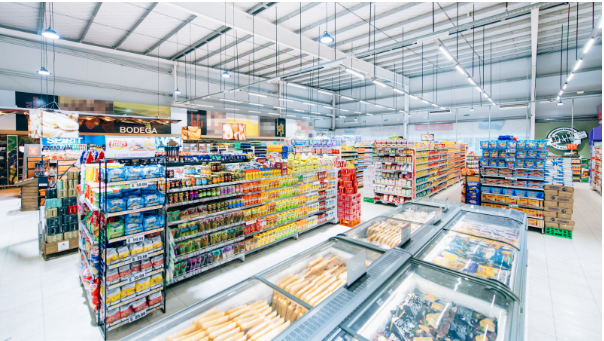
Supermarket space is often limited, making it crucial to maximize every inch from floor to ceiling. Display smaller items with high impulse purchase potential, such as dips and small snack bags, near existing shelves can increase visibility and sales.
Leveraging key areas of the store, such as end caps, checkout lines, deli and bakery areas can also lead to greater customer engagement and increased sales.
The checkout area presents an excellent opportunity for cross-selling last-minute items. Sell items such as snacks or beverages to customers waiting in line. Additionally, the deli and bakery areas are frequented by shoppers looking for creative products to add to their meals. This makes it an ideal spot for strategically placed displays.
Carefully considering aisle layout is also crucial. Many supermarkets have designated 4×4 spots for pallet drops such as pallets of fruit or in football season they might place pallets of chips or snacks. Our 4×4 shop-around is ideal for these types of spots.
Well-designed racks and shelves that maximize space usage ensure that every product is showcased efficiently and accessibly. Utilizing vertical space, adding hooks, or incorporating adjustable shelves can increase the display’s capacity while maintaining an organized and visually appealing arrangement.
Food Display: The Key to Successful Retail Strategies
It’s clear: food displays play a pivotal role in maximizing sales and revenue for supermarkets. Understanding customer behavior, creating engaging displays, and leveraging cross-merchandising opportunities, brands can set themselves apart from the competition and thrive in the highly competitive supermarket environment.
A combination of visual appeal, strategic positioning, and efficient use of space can lead to substantial sales growth and increased brand recognition. Achieve all of this, if the above advice is followed. All it takes is some careful planning and the right choice of racking and display products.
Maximize Your Supermarket Displays with Bordertown Retail
For more advice and guidance on creating effective displays, feel free to reach out to Bordertown Retail Systems. Our team of experts is dedicated to help your brand achieve exceptional results through impactful displays that resonate with customers and increase revenue. Together, let’s take your supermarket sales to new heights.



